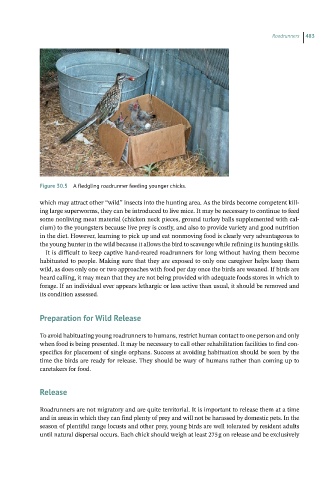Page 487 - Hand rearing birds second
P. 487
Roadrunners 483
Figure 30.5 A fledgling roadrunner feeding younger chicks.
which may attract other “wild” insects into the hunting area. As the birds become competent kill-
ing large superworms, they can be introduced to live mice. It may be necessary to continue to feed
some nonliving meat material (chicken neck pieces, ground turkey balls supplemented with cal-
cium) to the youngsters because live prey is costly, and also to provide variety and good nutrition
in the diet. However, learning to pick up and eat nonmoving food is clearly very advantageous to
the young hunter in the wild because it allows the bird to scavenge while refining its hunting skills.
It is difficult to keep captive hand‐reared roadrunners for long without having them become
habituated to people. Making sure that they are exposed to only one caregiver helps keep them
wild, as does only one or two approaches with food per day once the birds are weaned. If birds are
heard calling, it may mean that they are not being provided with adequate foods stores in which to
forage. If an individual ever appears lethargic or less active than usual, it should be removed and
its condition assessed.
Preparationfor WildRelease
To avoid habituating young roadrunners to humans, restrict human contact to one person and only
when food is being presented. It may be necessary to call other rehabilitation facilities to find con-
specifics for placement of single orphans. Success at avoiding habituation should be seen by the
time the birds are ready for release. They should be wary of humans rather than coming up to
caretakers for food.
Release
Roadrunners are not migratory and are quite territorial. It is important to release them at a time
and in areas in which they can find plenty of prey and will not be harassed by domestic pets. In the
season of plentiful range locusts and other prey, young birds are well tolerated by resident adults
until natural dispersal occurs. Each chick should weigh at least 275 g on release and be exclusively

